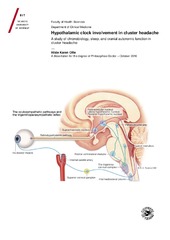Hypothalamic clock involvement in cluster headache. A study of chronobiology, sleep, and cranial autonomic function in cluster headache
Permanent lenke
https://hdl.handle.net/10037/9856Åpne
Thesis (PDF)
Paper 1: Ofte, H. K., Berg, D. H., Bekkelund, S. I., Alstadhaug, K. B.: «Insomnia and periodicity of headache in an Arctic cluster headache population”. Also available in Headache 2013, 53(10):1602-12.
(PDF)
(PDF)
Paper 2: Ofte, H. K., Tronvik, E.., Alstadhaug, K. B.: «Lack of association between cluster headache and PER3 clock gene polymorphism”. Also available in The Journal of Headache and Pain 2016, 17(1):18 .
(PDF)
(PDF)
Dato
2016-10-24Type
Doctoral thesisDoktorgradsavhandling
Forfatter
Ofte, Hilde KarenSammendrag
Cluster headache has been claimed to be a chronobiological disorder because of its striking periodic occurrence. This suggests that the biological clock is involved in the pathophysiology of the disease, but few researchers have studied this in depth.
In this thesis, we have studied several aspects of chronobiology in cluster headache patients. First, we assessed the periodicity of headache attacks, the frequency of sleep disturbances and shift work employment in a cluster headache population living north of the Arctic Circle, a region with extreme variations in external light. We found that the periodicity of headache was the same here as in other cluster headache populations, but we also found a high frequency of chronic insomnia and shift work occupation among the patients.
Second, we sequenced a variable number tandem repeat DNA-sequence of the clock gene PERIOD3 in cluster headache patients. This is a core clock gene mutation known to be associated with preferred daily rhythm in healthy populations. A subpopulation of patients were also chronotyped, meaning that we assessed their preferred daily rhythms through validated questionnaires. Compared to a healthy population of Norwegian students, there was no difference in PERIOD3 genotype distribution. We also did not find certain deviations in chronotypes.
Finally, we studied cranial autonomic function in the remission phase of cluster headache. Thirty patients were examined in their headache-free period, undergoing light-reflex pupillometry, ultrasound measurement of the superficial temporal artery diameter and computer-assisted retinal vessel caliber measurements of both eyes. We found a significantly reduced parasympathetic response in the pupillary light reflex on both eyes, more pronounced on the symptomatic side, compared to controls. The retinal veins were also smaller on the symptomatic side compared to the asymptomatic side, possibly caused by reduced cranial parasympathetic tone. The findings suggest a central origin of the disease, and we propose a theory of hypothalamic involvement in cluster headache pathophysiology.
Beskrivelse
The paper 3 of this thesis is not available in Munin.
Paper 3: Ofte, H. K., von Hanno, T., Alstadhaug, K. B.: "Reduced cranial parasympathetic tone during the remission phase of cluster headache". Available in Cephalalgia 2015, 35(6): 466-77.
Paper 3: Ofte, H. K., von Hanno, T., Alstadhaug, K. B.: "Reduced cranial parasympathetic tone during the remission phase of cluster headache". Available in Cephalalgia 2015, 35(6): 466-77.
Forlag
UiT The Arctic University of NorwayUiT Norges arktiske universitet
Metadata
Vis full innførselSamlinger
Copyright 2016 The Author(s)
Følgende lisensfil er knyttet til denne innførselen:


 English
English norsk
norsk
